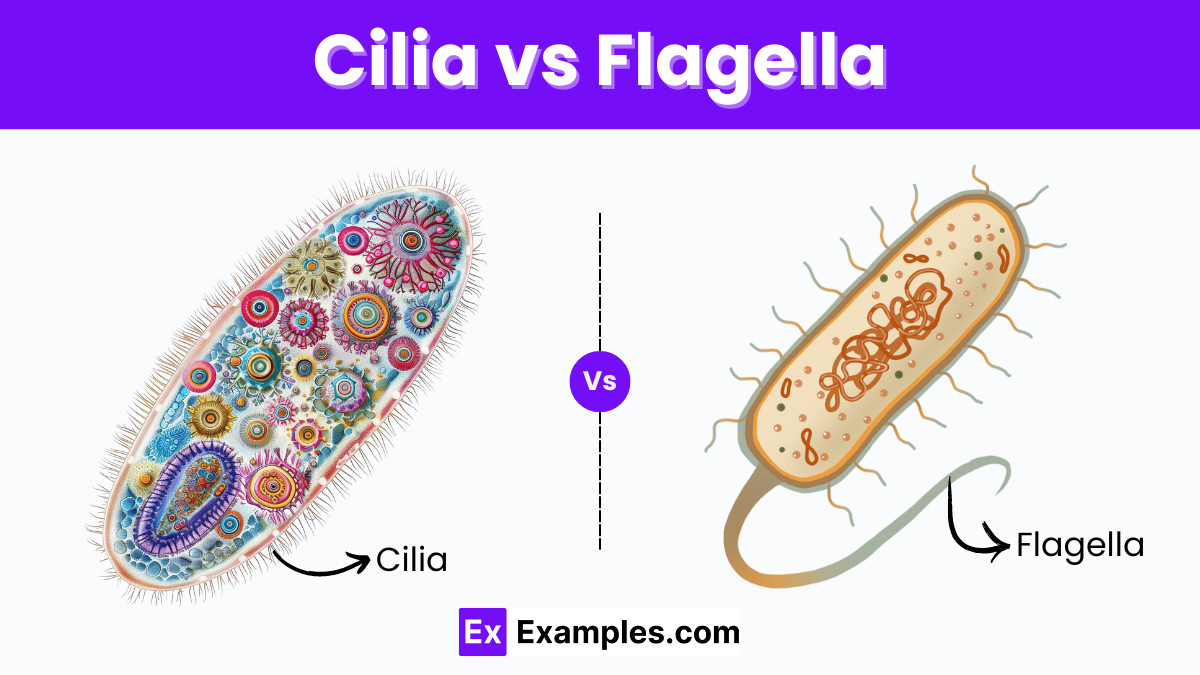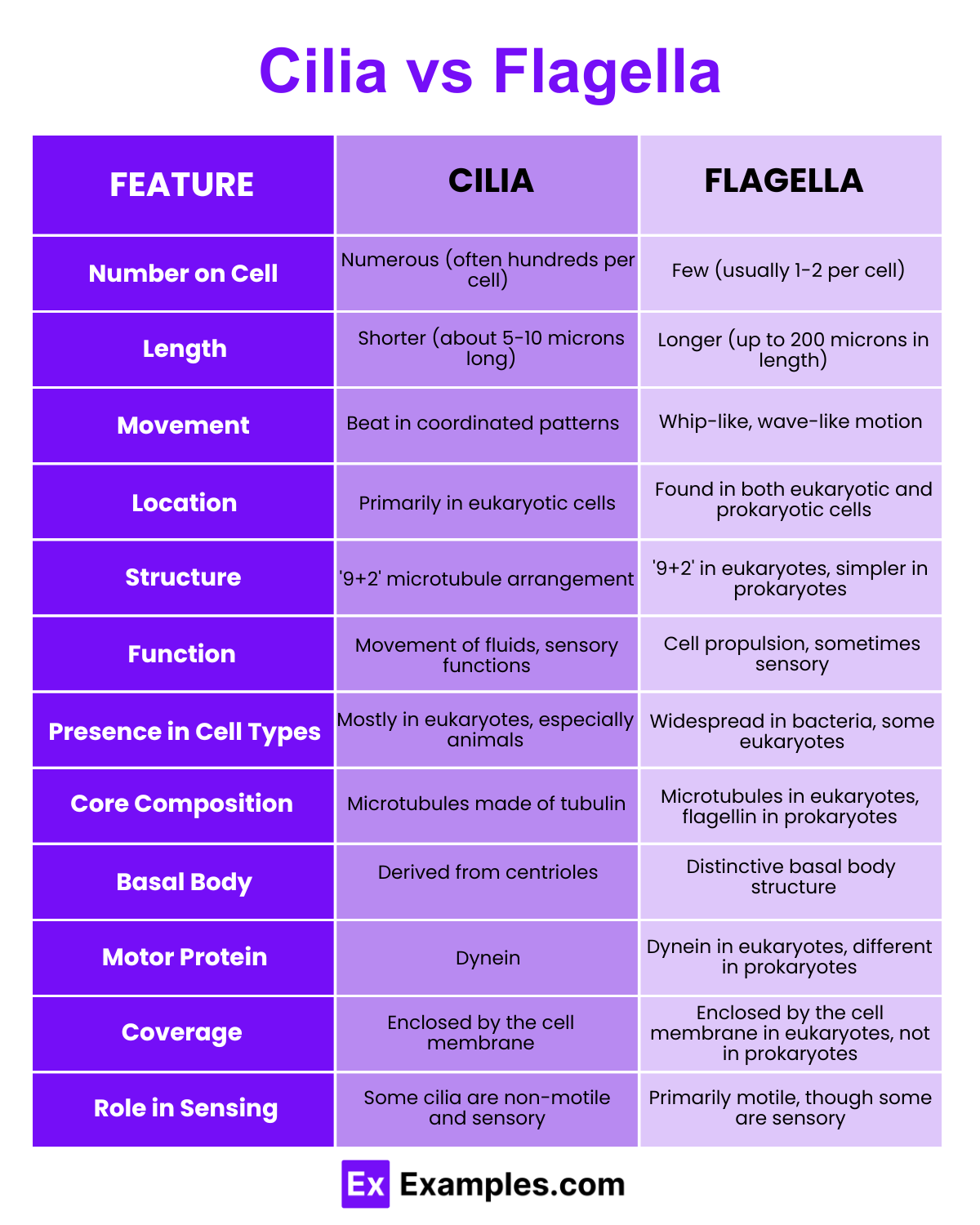Which of the following structures is typically shorter and more numerous on cells?
Flagella
Cilia
Microvilli
Pseudopodia


Cilia and flagella are vital cellular structures that play critical roles in cellular locomotion and sensory functions. Although both structures aid in movement, they differ significantly in their structure, distribution, and function. This article delves into the key differences and similarities between cilia and flagella, highlighting their unique contributions to cellular operations and organism survival.
Cilia are short, hair-like structures that extend from the surface of many eukaryotic cells. They are primarily composed of microtubules arranged in a ‘9+2’ structure and are enveloped by the cell membrane. Cilia can be classified into two types: motile and non-motile.
Flagella are longer and usually fewer in number compared to cilia. Found in both eukaryotic and prokaryotic organisms, flagella serve primarily for locomotion. The structure of flagella can vary between these organisms:

| Characteristic | Cilia | Flagella |
|---|---|---|
| Length | Typically shorter, ranging from 5 to 10 micrometers. | Generally longer, can be up to 200 micrometers in length. |
| Number per cell | Cells usually have many cilia. | Cells typically have one or a few flagella. |
| Movement | Cilia move in a coordinated, wave-like pattern. | Flagella move in a whip-like manner, propelling the cell forward. |
| Function | Primarily involved in moving fluids, mucus, and other substances across the cell surface. Common in respiratory tract and fallopian tubes. | Mainly used for locomotion of the cell itself. Prominent in sperm cells and single-celled organisms like bacteria. |
| Structure | Cilia have a “9+2” arrangement of microtubules (nine pairs of microtubules arranged around two central microtubules) in most eukaryotic cells. | Flagella also have a “9+2” arrangement in eukaryotic cells, but bacterial flagella have a simpler structure without the microtubule arrangement. |
| Distribution | Found in eukaryotic cells, particularly in animals and protozoa. | Found in both eukaryotic and prokaryotic organisms; their structure and composition vary significantly between these groups. |
| Growth | Grows out from the cell surface. | Grows from the basal body located just inside the cell membrane. |
| Energy Consumption | Require substantial energy to beat rhythmically, provided by ATP. | Also energetically demanding, using ATP to power their undulating motion. |
| Examples | Cilia are found in the lining of the human respiratory tract, where they help to clear mucus and debris. | Flagella are observed in bacteria like E. coli and in human sperm, aiding in mobility. |
| Speed of Movement | Typically slower due to their coordinated back-and-forth motion. | Capable of rapid and agile movement, enhancing mobility. |
| Sensory Roles | Some cilia are non-motile and serve as sensory organelles, detecting molecular changes in the environment. | Sensory functions are less common in flagella but can be seen in some specialized cells to detect changes in the chemical composition of their surroundings. |
| Genetic Control | Controlled by a complex set of genes that regulate their development, structure, and function. | Similarly regulated by a complex genetic setup, but bacterial flagella have distinct genes like those found in the flagellar motor complex. |
| Regeneration | Capable of quick regeneration which is essential for maintaining their dense arrangements on cell surfaces. | Regeneration occurs at a slower rate due to their more complex structure and singular presence. |
Both cilia and flagella primarily consist of microtubules arranged in a specific pattern known as the ‘9+2’ structure. This arrangement includes nine doublet microtubules that circle two central singlet microtubules. We refer to this core structure as an axoneme, which is crucial for the movement of these organelles.
An extension of the cell membrane covers both organelles, integrating them into the cell’s overall structure and facilitating their movement mechanisms.
The motor protein dynein powers the movement of both cilia and flagella. Dynein arms, attached to the microtubules, use ATP to induce sliding between the microtubules, resulting in the bending of cilia and flagella that generates movement.
Both cilia and flagella originate from a basal body, which anchors the organelle to the cell surface. The basal body is structurally similar to a centriole, another cellular component important in cell division. This base helps organize the microtubule assembly of cilia and flagella and ensures their proper positioning and function within the cell.
In many eukaryotic cells, both cilia and flagella are involved in movement—either of the cell itself or of fluids surrounding the cell. Additionally, non-motile cilia play roles in sensory functions, detecting environmental cues that are critical for cellular responses.
Cilia and flagella are primarily features of eukaryotic cells. They are present across a wide range of eukaryotes, from single-celled organisms to complex multicellular animals, including humans.
Both structures share common protein components, including tubulin, which forms the microtubules, and various motor proteins and linkers that assist in their movement and stability.
Cilia are numerous and short, aiding movement and sensing, while flagella are fewer and longer, primarily for locomotion.
Cilia move fluid, mucus, or cells; flagella propel organisms through their environments.
Cilia are microtubule-based structures for movement or sensing; pili are protein filaments in bacteria for adhesion and conjugation.
Cilia are found exclusively in eukaryotic cells, serving various sensory and locomotive functions.
Not all prokaryotes have flagella; cilia are absent in prokaryotes.
Text prompt
Add Tone
10 Examples of Public speaking
20 Examples of Gas lighting
Which of the following structures is typically shorter and more numerous on cells?
Flagella
Cilia
Microvilli
Pseudopodia
The main function of flagella in a bacterial cell is to:
Move substances along the surface of the cell
Produce proteins
Propel the cell
Support cell division
Which of the following statements best differentiates cilia from flagella?
Cilia are long, while flagella are short.
Cilia move substances across the cell, while flagella move the cell itself.
Cilia are found only in bacteria.
Flagella beat in a coordinated manner, while cilia rotate.
In which organisms are both cilia and flagella typically found?
Only in plants
Only in prokaryotes
Only in animals
In both eukaryotes and prokaryotes
What is the key structural difference between eukaryotic and prokaryotic flagella?
Eukaryotic flagella are made of flagellin, while prokaryotic flagella are made of microtubules.
Eukaryotic flagella have a 9+2 microtubule arrangement, while prokaryotic flagella do not.
Eukaryotic flagella are powered by ATP, while prokaryotic flagella use sunlight.
Eukaryotic flagella rotate, while prokaryotic flagella beat.
Which of the following is true regarding the movement of cilia and flagella?
Both cilia and flagella move in a whiplike motion.
Cilia move in a coordinated wave-like motion, while flagella move in a whip-like motion.
Cilia rotate, while flagella undulate.
Both cilia and flagella rotate around the cell.
In humans, where are cilia commonly found?
In red blood cells
In nerve cells
Lining the respiratory tract
In the digestive tract
The protein that forms the core structure of eukaryotic flagella and cilia is:
Actin
Tubulin
Keratin
Myosin
How do flagella in bacteria move?
By beating in a coordinated manner
By rotating like a propeller
By expanding and contracting
By swinging back and forth
Which type of cell movement is most commonly associated with cilia?
Swimming in a liquid medium
Moving solid particles across a surface
Rotating around the cell's axis
Facilitating cell division
Before you leave, take our quick quiz to enhance your learning!

